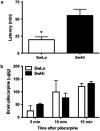Seizure susceptibility and epileptogenesis in a rat model of epilepsy and depression co-morbidity
- PMID: 22871911
- PMCID: PMC3499730
- DOI: 10.1038/npp.2012.141
Seizure susceptibility and epileptogenesis in a rat model of epilepsy and depression co-morbidity
Abstract
Although a strong co-morbidity exists clinically between epilepsy and depression, the cause of this co-morbidity remains unknown, and a valid animal model is crucial for the identification of underlying mechanisms and the development of a screening tool for novel therapies. Although some rodent models of epilepsy have been reported to display behaviors relevant to affective disorders, the seizure susceptibility of animals prone to depression-like behavior has not been characterized. Toward this end, we assessed several forms of seizure sensitivity and epileptogenesis in rats selectively bred for vulnerability (Swim Lo-Active; SwLo) or resilience (Swim High-Active; SwHi) to depression-like phenotypes. The SwLo rats exhibit decreased motor activity in a swim test and other depression-like phenotypes, whereas the SwHi rats display increased motor activity in a swim test. SwLo rats exhibited a decreased latency to limbic motor seizures following acute pilocarpine administration in the absence of differences in pilocarpine pharmacokinetics, and also had a decreased threshold to tonic seizures induced by electroshock. Approximately half of the SwLo rats, but none of the SwHi rats, had spontaneous limbic motor seizures 5 weeks following pilocarpine-induced status epilepticus. While the number of stimulations required to achieve full amygdala and hippocampal electrical kindling were similar in the two rat lines, SwLo rats had a lower final hippocampal kindling threshold and more wet dog shakes during both amygdala and hippocampal kindling. Combined, these results indicate that SwLo rats are a model of epilepsy and depression co-morbidity that can be used for investigating underlying neurobiological and genetic mechanisms and screening novel therapeutics.
Figures



Similar articles
-
Antidepressant and anticonvulsant effects of exercise in a rat model of epilepsy and depression comorbidity.Epilepsy Behav. 2013 Oct;29(1):47-52. doi: 10.1016/j.yebeh.2013.06.023. Epub 2013 Aug 8. Epilepsy Behav. 2013. PMID: 23933912 Free PMC article.
-
Selective breeding of rats for high and low motor activity in a swim test: toward a new animal model of depression.Pharmacol Biochem Behav. 1998 Sep;61(1):49-66. doi: 10.1016/s0091-3057(98)00075-6. Pharmacol Biochem Behav. 1998. PMID: 9715807
-
Something new and something blue: Responses to novelty in a rodent model of depression and epilepsy comorbidity.Physiol Behav. 2022 May 15;249:113778. doi: 10.1016/j.physbeh.2022.113778. Epub 2022 Mar 9. Physiol Behav. 2022. PMID: 35278474
-
Rhythm and blues: animal models of epilepsy and depression comorbidity.Biochem Pharmacol. 2013 Jan 15;85(2):135-46. doi: 10.1016/j.bcp.2012.08.016. Epub 2012 Aug 23. Biochem Pharmacol. 2013. PMID: 22940575 Free PMC article. Review.
-
An animal model of genetic predisposition to develop acquired epileptogenesis: The FAST and SLOW rats.Epilepsia. 2019 Oct;60(10):2023-2036. doi: 10.1111/epi.16329. Epub 2019 Aug 29. Epilepsia. 2019. PMID: 31468516 Review.
Cited by
-
Antidepressant and anticonvulsant effects of exercise in a rat model of epilepsy and depression comorbidity.Epilepsy Behav. 2013 Oct;29(1):47-52. doi: 10.1016/j.yebeh.2013.06.023. Epub 2013 Aug 8. Epilepsy Behav. 2013. PMID: 23933912 Free PMC article.
-
Therapeutic potential of endothelial progenitor cells in a rat model of epilepsy: Role of autophagy.J Adv Res. 2019 Jan 31;18:101-112. doi: 10.1016/j.jare.2019.01.013. eCollection 2019 Jul. J Adv Res. 2019. PMID: 30847250 Free PMC article.
-
Olfactory Bulbectomy Leads to the Development of Epilepsy in Mice.PLoS One. 2015 Sep 14;10(9):e0138178. doi: 10.1371/journal.pone.0138178. eCollection 2015. PLoS One. 2015. PMID: 26368332 Free PMC article.
-
Issues related to symptomatic and disease-modifying treatments affecting cognitive and neuropsychiatric comorbidities of epilepsy.Epilepsia. 2013 Aug;54 Suppl 4(0 4):44-60. doi: 10.1111/epi.12298. Epilepsia. 2013. PMID: 23909853 Free PMC article. Review.
-
A reliable method for intracranial electrode implantation and chronic electrical stimulation in the mouse brain.BMC Neurosci. 2013 Aug 6;14:82. doi: 10.1186/1471-2202-14-82. BMC Neurosci. 2013. PMID: 23914984 Free PMC article.
References
-
- Barry JJ, Ettinger AB, Friel P, Gilliam FG, Harden CL, Hermann B, et al. Consensus statement: the evaluation and treatment of people with epilepsy and affective disorders. Epilepsy & Behavior. 2008;13 (Suppl 1:S1–29. - PubMed
-
- Bortolotto ZA, Cavalheiro EA. Effect of DSP4 on hippocampal kindling in rats. Pharmacol Biochem Behav. 1986;24:777–779. - PubMed
-
- Boylan LS, Flint LA, Labovitz DL, Jackson SC, Starner K, Devinsky O. Depression but not seizure frequency predicts quality of life in treatment-resistant epilepsy. Neurology. 2004;62:258–261. - PubMed
-
- Bragin A, Wilson CL, Engel J., Jr Increased afterdischarge threshold during kindling in epileptic rats. Exp Brain Res. 2002;144:30–37. - PubMed
-
- Cramer JA, Blum D, Reed M, Fanning K. The influence of comorbid depression on seizure severity. Epilepsia. 2003;44:1578–1584. - PubMed

